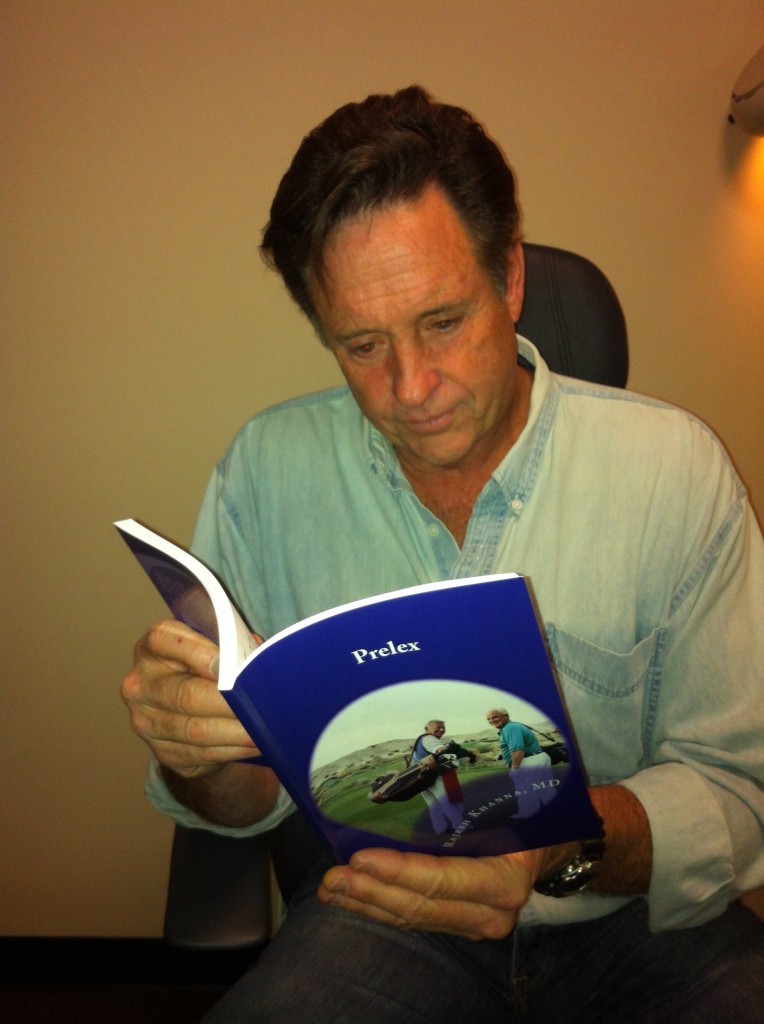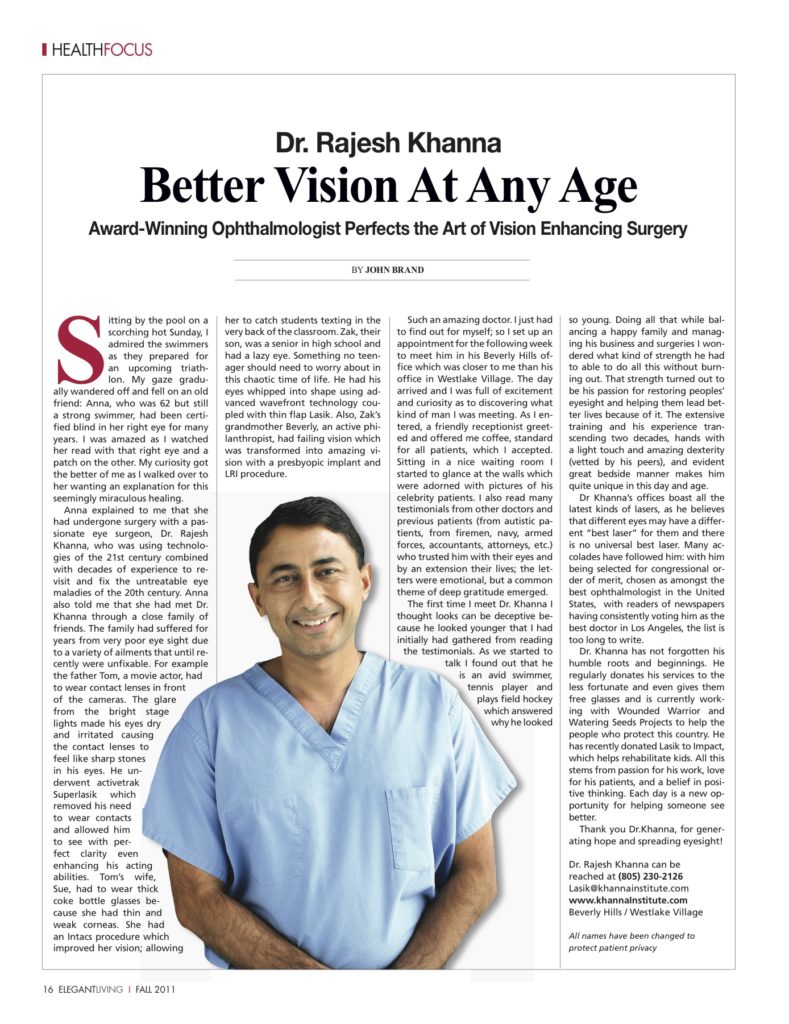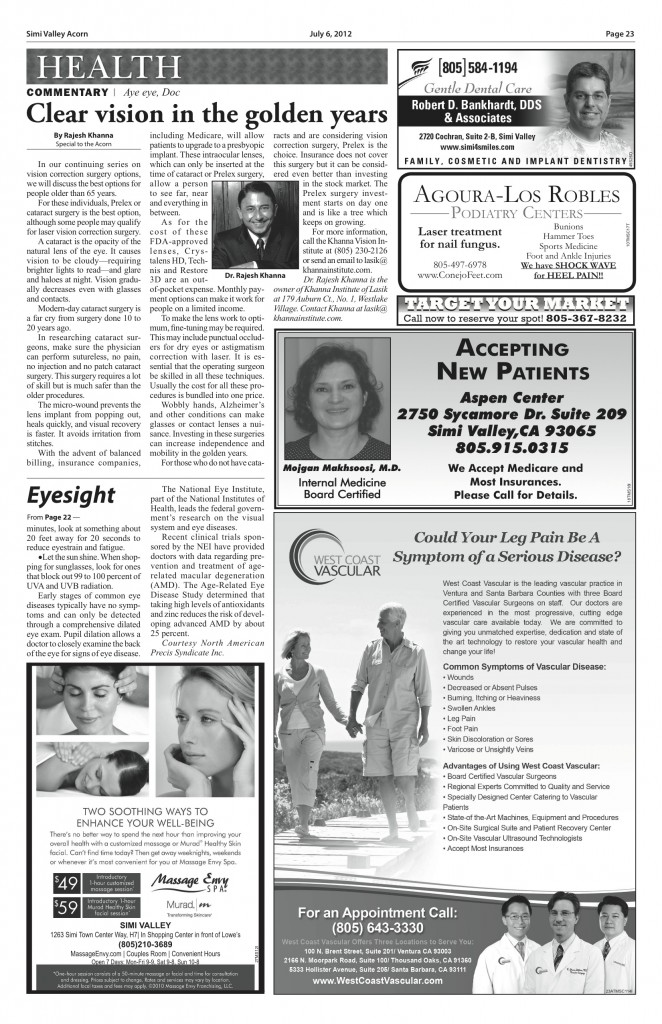Can you explain what Presbyopia is and why it develops later on in adult life? What are bifocals and what kind of eye patients require them? What is the difference between bifocals and varifocals? How does PRELEX surgery treat Presbyopia and why is LASIK surgery not applicable in this case? Can the correction of Presbyopia with PRELEX surgery prevent any other eye disorders from developing in the future? All of these questions will be answered by:Dr. Rajesh Khanna – Ophthalmologist and Surgeon who is internationally recognized as a LASIK and refractive vision care specialist.
Category: presbyopia
IndUS Business Journal features Prelex author
Issue Date: November 2012, Posted On: 11/23/2012
Lasik specialist writes book on benefits of ‘Prelex’
“Prelex,” above and Khanna, below.
Beverly Hills Lasik surgeon Dr. Rajesh Khanna decided to follow in the path of Doctors Chopra and Gupta, and compile a book titled “Prelex,” which is receiving rave reviews on Amazon. As it is discussed in the book, the Prelex procedure allows individuals over 45 to see near, middle and distance in each eye (not monovision) without the use of glasses or contacts. This procedure also prevents the development of cataracts. Patients describe Prelex as, “miraculous” and “life changing.” According to Khanna, the book is aimed at all people above 45 years of age including baby boomers and seniors.
Khanna is board certified by the American Board of Ophthalmology. He has specialized training in LASIK, Prelex, Cataract and Corneal surgery from the University of Cincinnati. Khanna is known as the Lasik surgeon to the stars, as he has performed over 10,000 vision correction procedures on many Olympic medal winners and Hollywood personalities like Disney stars Brenda Song and Corbin Bleu, “Hercules” Kevin Sorbo, UFC champion fighter Bas Rutten, and Butch Patrick who played Eddie Munster. He also performs Intacs Surgery for Keratoconus. Khanna is a voluntary member of the UCLA faculty, as well as of the American Academy of Ophthalmology and the American Society of Cataract and Refractive surgery. The Khanna Vision Institute has centers in Beverly Hills and Westlake Village.
To see the actual article click here
Law Firm
FRANCHISE:
C-store/Petroleum
Education
Financing
Hair Salon
Health Care
Hotel/ Hospitality
Franchise Law Firm
Restaurant/Food
Satellite/ Communication
Service
Organization
Add Your Listing
Partners
Log In – About Us – Search – Archives
Copyright © 2012 IndUS Business Journal All rights reserved. | Console Login
Prelex interview on Time Warner Cable
100 seniors in 1000 oaks
More than 100 seniors came to Thousand Oaks on Oct. 18 to hear a talk by Dr. Rajesh Khanna, a board-certified and internation- ally recognized Lasik surgeon who specializes in disorders of the eye.
The event at Los Robles Hos- pital was part of the hospital’s ongoing health chat series that features a variety of doctors offer- ing medical advice to community members.
Khanna discussed the signifi- cance and development of cata- racts and the most promising and advanced treatment called Prelex, a replacement of the eye’s lens.
Khanna began his discus- sion by explaining the structure of the eye and the changes that occur over time. One of the most common eye aliments is cataracts. More than 20.5 million Americans over the age of 45 are affected by cataracts each year.
A cataract is the natural dete- rioration of the lens and can cause blurry vision. If the cataract is advanced it can make it extremely difficult to see.
Common treatments that are often recommended include drops and vitamins, but Khanna said research shows that neither of those options is useful. Instead, he suggests the cataract procedure.
Forms of cataract surgery have been in existence for hundreds of years, but procedures weren’t refined until modern cataract surgery was developed about 40 years ago. Recent advances in refractive cataract and Prelex procedures take the treatment to a new level.
Laser-assisted cataract sur- gery, for example, can also cor- rect astigmatism. Cataract surgery can be performed even in the presence of dry macular degen- eration.
Khanna also talked about an- other benefit of Prelex in which presbyopic implants, such as
Restore, Tecnis and Crystalens, are used as the eye’s new lens and are able to improve its ability to see up close.
Presbyopia is a condition in which the lens of the eye loses its ability to focus on close-up objects.
People over 50 who become dependent on reading glasses are excellent candidates for Prelex surgery, said Khanna, whose new book, “Prelex,” is available on Amazon.com.
Khanna’s website is www. khannainstitute.com. His offices are in Thousand Oaks and Bev- erly Hills.
Pi in the eye
Pi is the acronym coined by the author of the book Prelex. It is a shortened form of presbyopic implants. These implants are inert plastic (acrylic or silicon to get technical) which reverse presbyopia or ageing eyes permanently.
They sit quietly working 24/7 without asking for a cost of living hike. 24/7 you ask? Well you got to see your dreams clearly too.
There are two kinds of Pi. Accommodative and multifocal. They have a different mode of actions. In the book prelex there is a chapter devoted to pi in the eye. This chapter discusses in detail the advantages of each type of Pi.
Remember you eat pie and see with pi.
Robert Hayes reading Prelex book
Focus on Eyes to improve focus of eyes
Eye Column Clear Vision in Golden Years
Malibu Chronicle says Book on Prelex very useful
Beyond Lasik – Prelex Eye Surgery
Beyond Lasik: Eye Surgery for the Rest of Us – Prelex
By Veera Mahajan
Dr. Rajesh Khanna in Los Angeles, knows a thing or two about the eye. As a practicing optical specialist, he’s helped countless patients finally put glasses and contacts to rest. But is surgery right for everyone? Are there options beyond the famous “lasik surgery”?
Dr. Khanna explains in his new book Prelex, the inner workings of the eye and the changes that happen as we age. “At a certain point people pass the Lasik stage” explains Dr. Khanna, “Mostly it’s the baby boomer generation. Their eye just can’t handle the surgery anymore.”
Enter Prelex, or Presbyopic refractive lens exchange. Dr. Khanna summarizes: “Presbyopia is when the muscles of the eye are not able to move the lens. When we see far then near, the eye power has to change. As the eye gets old, the lens becomes thicker and the space for it decreases. By 45-50 years of age the lens is not able to accommodate the thickening of the muscle. So, it starts affecting the eye sight, first the near and, gradually, the far.”
Basically the eye can’t handle the constant stress of looking from a book to, say, a clock across the room. So how can Prelex help?
“With Prelex we can correct everything. Far sightedness, near sightedness, stigmatism, you name it” explains Dr. Khanna. He stresses that it is nothing like Lasik. “Lasik is a superficial surgery. Prelex requires the implant of lenses. Lasik does not. It’s much more detailed.” It takes a much higher degree of skill which makes it more expensive but according to Dr. Khanna it’s worth it:
“Imagine never having to worry about cataracts again. It’s pretty incredible. We take out the old lens and put in a new one. The new lens never wears out, so they never change shape. It’s not bi-focal, it’s beyond that.”
Dr. Khanna is one of the few eye surgeons who perform this new and highly effective surgery in LA. He quoted Lasik at $2750 per eye and said that Prelex is 3 times the cost of Lasik at $7500 per eye. There is a difference in the price because there is big difference in the two procedures. While Lasik is done in a clean manner, Prelex is done in a sterile manner. It is done in an operating room and a much higher level of skill is required to perform Prelex. All that adds up to the higher cost.
But with Dr. Khanna, this price includes surgery center fee, lens fee, maintenance and everything after the surgery. He includes fine tuning and follow up, which most doctors don’t.
“I like to give a personal touch to my patients and their satisfaction is my goal” says Dr. Khanna, “That’s what’s worth it to me.” He guarantees his work. As long as he is practicing, his patients can come back for fine tuning to him. His goal is for the patient to be happy and satisfied.
He uses different lenses based on the life style of the patient. For example he has lens that can stand trauma, for a patient who is into martial arts.
He realizes the cost is high. So, for special cases, he will consider genuine financial difficulties.
In general Lasik is 7 times safer than contacts. With Dr. Khanna, who has done thousands of Lasiks and has the latest equipment, Lasik is 100 times safer than wearing contacts. If you have had infection twice due to contact lenses, he thinks you should consider Lasik and if you are older than 40, Prelex is your best bet.
The risk of this surgery is minimal and less than getting hit by a car while driving in LA. He teaches how to pro-actively prevent infections, complications, etc. Patient satisfaction is so important to him that gives all his patients his cell phone number. He wants to be available to them when they need him.
Dr. Khanna encourages patients to come in and decide which procedure is right for them. You can read his book on his blog, as well as learn other fun facts about eye care.
http://www.khannainstitute.com/blog.html
Dr. Rajesh Khanna
Prelex, The Book explains what are the different components in the eye and what differences occur as we age. Near and far sightedness, stigmatism and estopia (old eye). Baby boomers pushed Lasik a lot. But they have crossed or passed the Lasik stage now.
For article in Malibu chronicle
Short URL: http://www.malibuchronicle.com/?p=1637
India Journal says buy Prelex Book
Lasik or Prelex? – Dr Rajesh Khanna Answers

The book ‘Prelex’
BY K B NAIR
Rajesh Khanna, MD is board certified by the American Board of Ophthalmology. He has specialized training in LASIK, Prelex, Cataract, and Corneal surgery from the University of Cincinnati. He is known as the LASIK surgeon to the stars, as he has performed over 10,000 vision correction procedures on many Olympic medal winners and Hollywood personalities
Khanna has just released a book titled ‘Prelex’ which is a relatively new procedure which was approved by the FDA in 2005 and the results of which since then have been excellent when done by skilful eye caregivers. The surgeon explained that a few years ago Lasik became extremely popular but 7 or 8 years ago it became evident that it did not work very well for everybody, especially those over the 45-50 age bracket. The Prelex procedure allows individuals over this age to see near, middle, and distance in each eye (not monovision) without the use of glasses or contacts.
According to Dr Khanna, Lasik was suitable for not more than 30-40 million of the US population whereas Prelex would be the preferred procedure for over 132 million people in the country. He added that everyone over 45 should be knowledgeable about this procedure and when he found 3 or 4 years ago these patients were not receiving the proper advice he decided to write a book which is reported to be selling very well.
The book explains in simple terms that in a normal eye adjusts its focus because the lens changes shape but with age it hardens and loses the ability and therefore needs replacement. Till now there were no lenses to mimic the human eye but now with nanoengineering technology it is possible to create lenses which can see far and near.

Dr Rajesh Khanna
Lasik has certain disadvantages when compared to Prelex in that Lasik could develop dry eyes and there is a certain loss in depth of perception and vision can still change. In some older patients they even develop cataracts. The advantage of Prelex over Lasik is that it is a permanent fix and vision will not change for the rest of one’s life, cataracts will not develop and one can see far and near without losing depth of perception and vision will actually improve with time.
Because of the fact Prelex is done in a sterile surgical suite and under anesthesia the cost of the procedure is higher than. The charges vary from city to city but as an example the average cost of Lasik in Beverly Hills would amount to $5,000 to 6,000 where Prelex would run from $12-15,000 for two eyes. The down side is that it is not covered by insurance but under certain circumstances Medicare does cover part of the charges.
Lasik surgery takes about 2 minute per eye whereas Prelex takes between 7 and 8 minutes. While Dr Khanna laughs and states some patients would like to get straight back to work, he does not recommend it. Also in accordance to US standards there is a recommended gap of at least 2 weeks between the procedure on the two eyes.
The book also describes how to be an educated consumer by learning to understand what qualities to look for in a Prelex surgeon, how to select an ideal facility and the questions to ask. This is important because only a handful of eye doctors have the skill to do it to perfection. Dr Khanna added such specialists need to already be good lasik, cataract and lens exchange surgeons.
Prelex can also be performed successfully on those who have already had Lasik or radial keratotomy procedures.
For more information: khannavision2020@gmail.com


